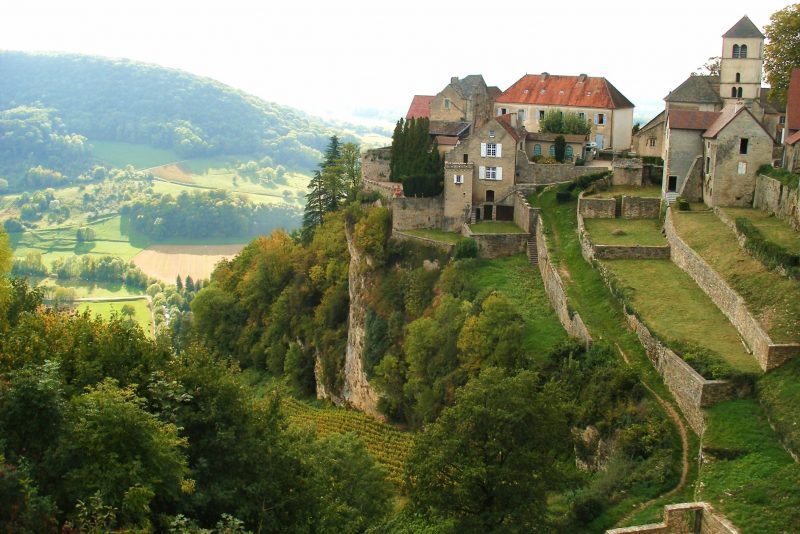“In the Jura, they don’t make cheese, they make Comté!”
The Jura is a small region in the east of France, bordering Switzerland. Green mountainous scenery, abundant forests interspersed with rich pastures and hedgerows, grazing cattle, horses, sheep and at almost every turn the celebrated vines of Jura.
In the Middle Ages, the Juraciens, in order to produce a cheese that could be readily transported and yet would keep well for long periods of time (winter here can be very severe) decided to pool their milk together, for at that time each farmer had only one or two milking cows and yet it required 450 litres of milk to make one Comté cheese!
Everyone shared the fruit of their labours together. This is why the centres where Comté cheese is made are still called Fruitières, though you will not find any fruit there! There the cheese-maker turns the milk into cheese which is then sent to a cave d’affinage where it is regularly washed, turned, inspected and sample-tasted over a minimum period of 6 months, but more often for 16, 24 or even 36 months. Each Comté cheese is different. To appreciate this, a small slice should be cut and smelt. The particular scents are every bit as varied as those of good wine and tell of the unique grasses, herbs and flowers of the specific pastures where the cows have fed.It must be pointed out that each cow must have a hectare of grazing and will only eat from the pasture in summer, and hay or “regain” (second and third cuts of hay) in the winter. Silage is prohibited for it destroys the natural taste of the cheese. And it is this unique taste which is the real treasure of Comté.The Juracians fully understand this. So industry and modernisation are only accepted if they do not in any way disturb the long slow process of the creation and maturation of their cheese, just like their wine.
This is a region that produces two of the finest if least known “white” wines of France:
The vin jaune (yellow wine); strongly acidic, it is left to mature in wooden casks for exactly six years and three months. Unlike other wines, the casks are never opened to “top up” the space left by normal evaporation. With any other wine such an empty space would lead to the wine turning to vinegar, but the vin jaune is protected by a crust of natural yeast that forms on the surface of the wine. This vin jaune is not only an exceptional wine, it can be used in the preparation of a quite excellent chicken dish, the famous Poularde au Vin Jaune.
Then there is the vin de paille (straw wine); luscious without being overly sweet – my favourite. Picked at the same time as the rest of the harvest, the grapes are left for weeks upon a bed of straw – from whence it takes its name. The grapes thus lose much of their water content but retain their taste and enhance their sweetness which, after vinification, produces this superb amber-coloured aperitif or desert wine. Here, as in the making of Comté cheese, time plays a crucial role. None of these excellent products can be made in a hurry; time alone confers upon them the depth and complexity of taste and smell which have always been their defining characteristics.On our visit to La Maison du Comté the interactive museum at Poligny, we tasted three samples of Comté: a youngster of 6 months, an adolescent of 16 months and a mature old timer of between two and three years. The experience was captivating! And when this cheese is accompanied by the appropriate local wine we are transported ….to a land where there is still the deepest respect for Man, for Nature, for their work together and……above all…. for Time.
-
Millefuille de Pommes au Comte
Ingredients (for 4 people)
*200g of Comte (grated)
*4 apples
*150g of sugar
*50g of butter
*1/2 lemon
*1 Stainless steel baking ring, 10cm diameter
Cooking Instructions
-Preheat the oven to 150C.
-Using the metal ring make 12 thin layers of grated Comté on a sheet of greaseproof paper. Cook to a light golden colour and set aside to cool.
-Clean, peel and cut each apple into 8 slices. Add a little lemon juice to prevent oxidisation.
-Heat the butter in a saucepan and caramelise the apples, adding sugar. The apples should become very soft.
-Place a layer of cheese on each of the four plates, then four slices of caramelised apple, then another layer of cheese, then four more slices of apple and finally cover with a third layer of cheese.
-Serve with rocket or lamb’s lettuce, seasoned with walnut oil and accompanied by a handful of grapes.
NOTE: This is well suited to the wines of Jura and the Millefeuille goes particularly well with a Vin de Paille. From outside Jura we also recommend the Hungarian wine Tokay 5 puttonyos.
Bon Appetit!






 Tootlafrance is Ireland’s fresh new eyes on France, bringing you the latest news, exclusive celebrity interviews, political analysis, cultural events, property news and, of course, travel features written by top Irish journalists.
Tootlafrance is Ireland’s fresh new eyes on France, bringing you the latest news, exclusive celebrity interviews, political analysis, cultural events, property news and, of course, travel features written by top Irish journalists.
i think there is a mistake ; the musee du comté is at POLIGNY and not at Pujol ; this village doesn’t exist in jura
Thank you for the comment. Yes, indeed there was a misprint – corrected now.